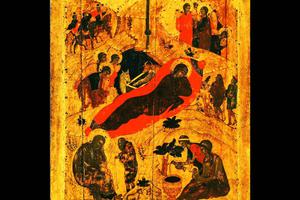Mary Is Truly the Holy Mother of God
‘The Virgin Mary ... is acknowledged and honored as being truly the Mother of God’ (Lumen Gentium 53)

Imagine this: Young Jesus, perhaps seven years of age, has been playing with his friends—skipping stones across the creek, tossing a stick for the dog to retrieve. Ready for lunch, he heads home and bounds through the door of his modest home; but Mary is there, and stops him in his tracks. “Wipe your feet!” she admonishes, pointing to the mud that's dripping from his sandals...
It's hard to imagine anyone telling the Son of God what to do! But Jesus was fully human, as well as fully God; and God had entrusted to his mother Mary the responsibility of helping the Child Jesus learn how to live in society. That means that Mary would have taught her divine Son the simple skills, the basic manners that were expected in the culture.
Yes, Mary Is God's Mother
On Jan. 1, Catholics celebrate the Solemnity of the Blessed Virgin Mary, the Mother of God. But for some Protestants—especially those in the Reformed and Evangelical traditions—the thought that Mary, a mere human who was created by God, should somehow be considered God's “mother” is a source of scandal. They look with disdain on what they regard as the undue honor with which Catholics regard Mary. They mistake hyperdulia, the very special honor which is accorded to Mary, with latria, the true worship which is given only to God.
If pressed, the same critics are likely to admit that they have studied the Church’s teachings on Mary very little or not at all, and that they have not seriously explored the rich history of Marian devotion—back, even, to the earliest days of the Church. Many don't realize that Martin Luther to his death believed the Marian dogmas which are today considered to be “Catholic,” and he approved of Marian paintings and statues in the churches of his time. Throughout his life, Luther had a deep devotion to the Rosary and to Mary.
The Divine Motherhood Is Really About the Identity of Jesus
Mary's divine motherhood was declared to be dogma by the Council of Ephesus in 431 not, as some might think, to honor Mary but rather, to clarify our understanding of who Jesus is.
In the fifth century, some theologians—Nestorius prominent among them—began to teach that Mary was the Mother of Jesus, but not of God. Nestorius debated the unity of Christ’s natures, saying that Mary gave birth to his human nature but not his divine nature.
Pope Celestine disagreed, asserting that Jesus’ two natures—fully God and fully man—could not be divided. Supported in his teaching by St. Cyril of Alexandria, Pope Celestine convened an ecumenical council at Ephesus, Mary’s place of residence in her old age, to discuss the issue. The bishops, all 200 of them, agreed that Mary was indeed the Mother of God (called, in Greek, the Theotokos or “God-Bearer”). The Nestorian teaching was deemed to be heretical.
The Four Marian Dogmas
In all, the Catholic Church lists four dogmas (truths revealed by God, which all Catholics must believe) regarding Mary. The first, her role as Mother of God, is what we celebrate on Jan. 1. But there are three other Marian dogmas which the Church professes:
- Mary’s perpetual virginity (Mary was and is Virgin before, in and after Christ's birth);
- her assumption into heaven (Mary, after finishing the course of her life on earth, was taken up in body and soul to heavenly glory); and
- her immaculate conception (that is, that Mary herself, as the “ark” which held the nascent Christ Child, was preserved from all sin by God in order to be a worthy vessel for the Divine Presence).
This article originally appeared Jan. 1, 2017, at the Register.
- Keywords:
- mother of god
- mary
















